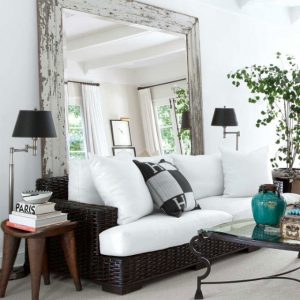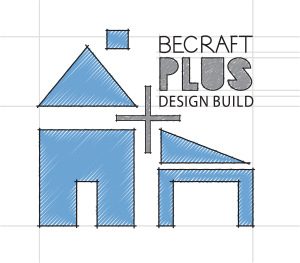
Room Flow is Important
In a large room, there are usually several ways for traffic to flow through it. In a small room, there might only be one way for guests to walk through your furniture without running into something. Your ability to walk through a room comfortably affects your perception of it. Thus, people feel better in a room if they can walk around unhindered. For example, in a combination living and dining room, you should put your large furniture, such as a sofa or television, against the outer walls to maximize the walk-able space within your room.
To implement this idea, remember…
- Avoid Swerving – Place furniture away from doorways and maintain an unbroken flow of movement through the space. For example, put long sofas against the wall instead of in the middle of the room.
- Define Boundaries – In a small space an easy way to make a room feel defined is with flooring. A rug can clearly separate two spaces and does not disrupt the flow. Other ideas include small chairs and low tables at strategic locations.
- Create a Path – Keep the pathway from the door into and out of your room clear. Any roadblocks within this pathway will make the room feel cramped and not properly designed.
Design Smaller Usable Areas
Although it may sound contradictory to divide your small room even further, think about doing so for rooms with several purposes. Think about what you use the room for, and then design the furniture around that.
Maybe you have a long, narrow, small room. You need to use it for entertaining, eating, and as a home office. By placing the bigger furniture, such as the sofa and desk, at opposite ends of the room along the walls and adding a smaller dining table in the middle, you maximize the use of the room without sacrificing your comfort. Define the rooms with flooring, art, or lighting, and use a single accent color to tie them all together.
Use of Color in Small Spaces
Experts argue over the best way to use color in small spaces. In general, there are two agreed upon ways to use color in small spaces. Choose the option that you prefer and that works best in your space.
- All Light Colors – White or light color schemes can make a room feel more open and larger. White can make a space feel less cluttered and brighter, tricking the eye into believing the room is larger than it really is.
- Bold Accent Colors – A single bold color can define a room’s boundaries better than light colors. People tend to feel more comfortable in a well-defined space. Use an accent wall or same-colored furniture to accomplish this. You can also go bold throughout the room. Dark walls can expand a room just like light walls: by tricking the eye. Dark grey walls can make a room feel cozy and brightly colored furniture can create a well-defined boundary.
Remember Balance and Symmetry
Avoid asymmetry when trying to make a room feel larger. You have the flow of the room set, so now you need to look for ways to add balance and symmetry. If you pair everything, for example, a pair of matching sofas or side tables, you can easily accomplish this.
Try to think of balance and symmetry throughout the room, not just with the furniture. Do you have a window on one side of the couch? Think about adding a similarly sized painting over the other side of the couch to mimic the window. This tip can trick the brain into believing there are two similar windows in the same room.
Finally, don’t forget the ceiling and floor. Using light colors on both will help make the room feel and look bigger. If your floors are already dark, consider adding a light colored rug or a bold accent wall to draw attention elsewhere.
Use Multi-Purpose Furniture
A small room needs furniture that serves several purposes because there simply might not be enough space for all desired pieces of furniture. For example, look for couches that include storage underneath or transform into a bed. Small items, such as side tables or ottomans, can include additional storage, serve as a coffee table, or become extra seating when needed.
In the kitchen, consider a counter-height table and stools instead of a traditional table and chairs. The higher table can double as extra prep space when needed and still provide a place to dine and hang out.
In a small bedroom, add a bed with built-in storage underneath or in the headboard, and a wardrobe with built-in drawers can be used in place of a stand-alone dresser.
Use Vertical Space
Don’t forget vertical space! While use of too much wall space in a small room can make it feel weighed down, taking advantage of a single wall can enhance your storage options while also creating a focal point. Consider a single bookshelf or several open shelves on the wall. Don’t forget about step #4, and balance them with something else.
Decorate Wisely
Remember that the things you add to decorate your small space, such as books, fruit bowls, or plants, all influence the overall design of your room. Try to choose things that will enhance your room, such as a mirror. Mirrors are a classic way to make a small space appear bigger, and they’re a classic for a reason. Mirrors bounce light into dark spaces and extend a room visually.
Another option is a large scale piece of art. A large piece can be used as a focal point or to add definition to a small space. Don’t forget about the color scheme of the room when choosing your artwork. Try to stick to a minimum or accent colors. Usually, two is a good number.
Creativity makes all the difference in remodeling your home! Becraft Plus has experience with making small rooms look larger. Contractor experience makes all the difference.
Contact Us (301-929-3401) For a Free Consultation!
—
 About Becraft Plus
About Becraft Plus
Since 1989, Becraft Plus has provided customized design and construction services to customers in the Washington, D.C. area. We specialize in custom home building, additions and remodeling, and whole house renovations with a focus on creating living spaces that are tailored to the needs of our clients.
>> Learn More

 About Becraft Plus
About Becraft Plus

